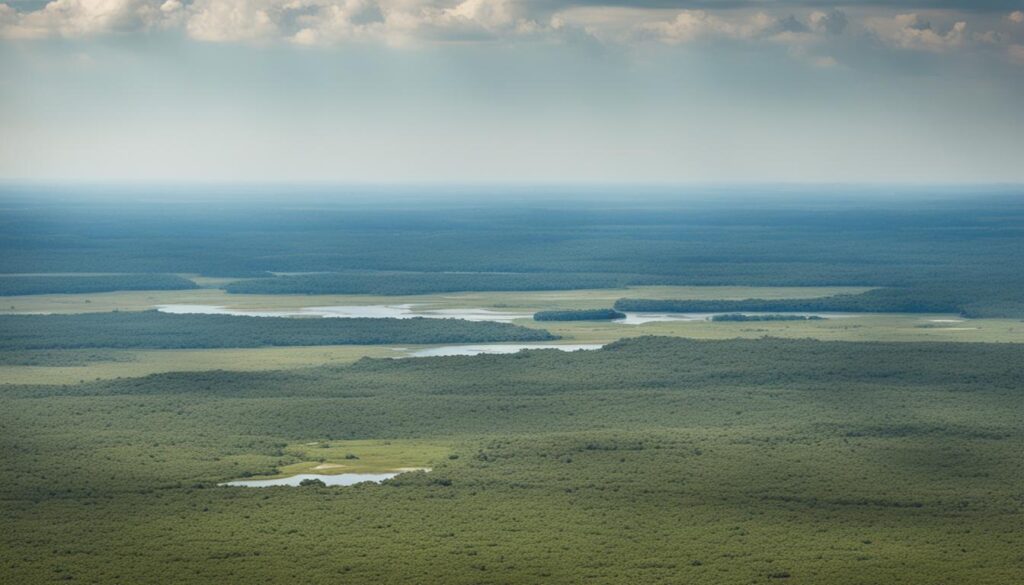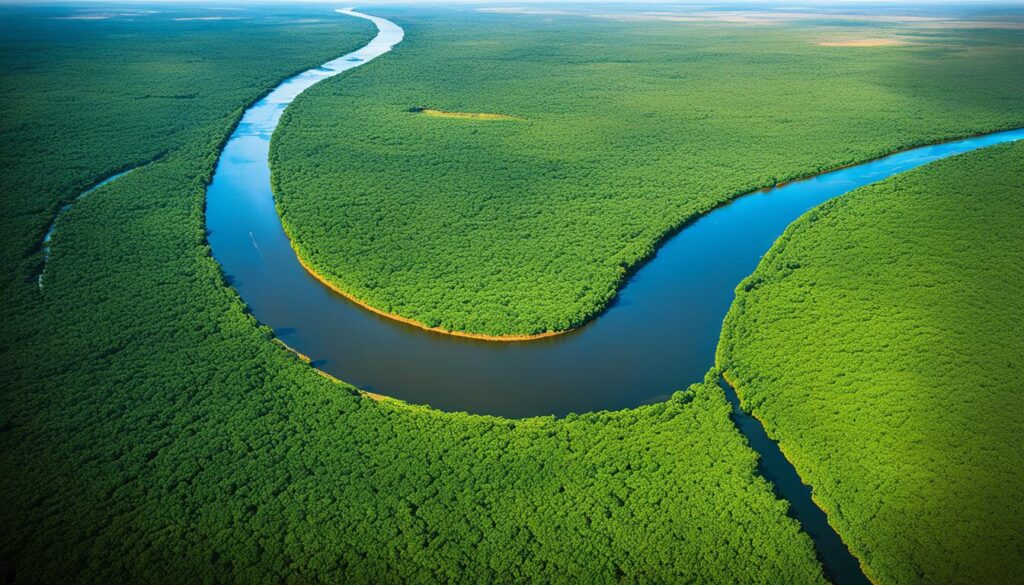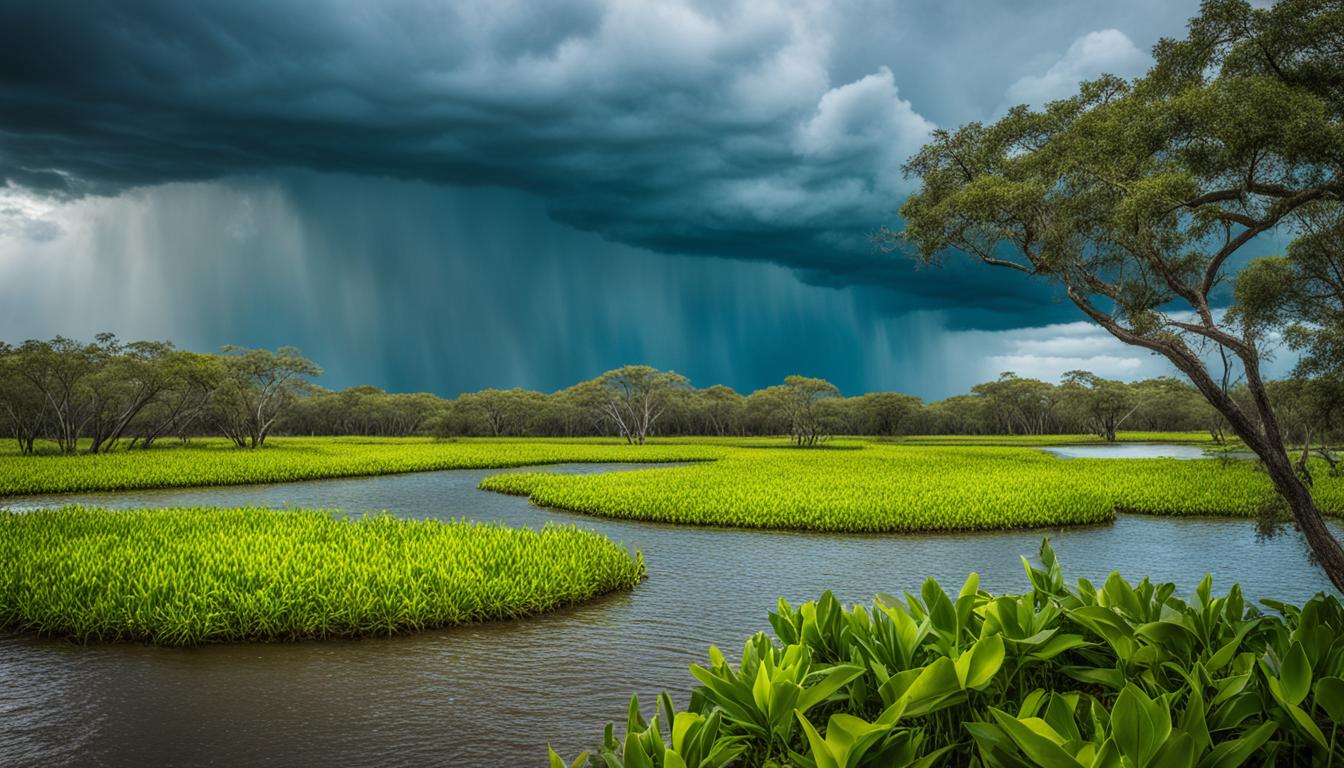The Pantanal is the world’s largest tropical wetland1. It stretches across Brazil, Bolivia, and Paraguay. This area is a hotspot for biodiversity1. It’s home to many plants and animals, like the jaguar1. But, it faces threats that could destroy its balance and existence.
Climate change and human actions like deforestation harm the Pantanal. The 2020 wildfires were a disaster, affecting the environment and local communities1.
Key Takeaways
- The Pantanal is the world’s largest tropical wetland, covering 17 million hectares1
- It is a biodiversity hotspot, home to over 2,000 plant species, 580 bird species, and numerous endangered animals1
- Climate change and human activities like deforestation have subjected the Pantanal to extreme weather events, such as devastating wildfires1
- The 2020 wildfires destroyed one-third of the Pantanal, killing an estimated 17 million vertebrate animals2
- Urgent action is needed to protect the Pantanal and its unique ecosystem from the growing threats of climate change and human impact.
Introduction: The Pantanal’s Ecological Significance
The Pantanal is a stunning natural wonder, known as the world’s largest tropical wetland3. It covers an area as big as the state of Florida, stretching over 185,000 square kilometers3. This vast floodplain is filled with grassland swamps, rivers, and dense savannas, all thanks to the Paraguay River and its tributaries3. When it rains, up to 80% of the Pantanal gets flooded3.
The Pantanal is more than a pretty view; it’s a hotspot for biodiversity, housing over 3,000 plant and animal species, many endangered4. It’s also a key place for jaguars, the biggest cats in the Americas, with a high number of them, second only to the Amazon4.
The Pantanal’s importance to nature is huge. It’s a vital ecosystem that supports many species, acting as a safe haven for them4. As we look at the challenges it faces, we see how crucial it is to protect this wetland for the environment and its inhabitants.
| Key Ecological Facts about the Pantanal | Data |
|---|---|
| Total Area | 185,000 square kilometers |
| Percentage Inundated during Rainy Season | Up to 80% |
| Number of Plant and Animal Species | Over 3,000 |
| Jaguar Population | Second-largest stronghold after the Amazon |
Threats Facing the Pantanal
The Pantanal, the world’s largest tropical wetland, is facing threats from human activities and climate change5. It spans across 185,000 square kilometers in Brazil, Bolivia, and Paraguay5. Despite being mostly privately owned, the native vegetation is still intact thanks to local ranchers’ sustainable practices5. However, this balance is now at risk as more land is being cleared for farming and grazing.
Deforestation and Human Activities
Deforestation and large-scale farming threaten the Pantanal5. Analysis shows that over 22 percent of the Pantanal in Brazil has burned since early 20206. In 2020, a quarter of the wetland in Brazil was ravaged by wildfires, mainly in August and September6. This has severely impacted the Pantanal’s biodiversity, home to over 47,000 species, many endangered5.
Climate Change and Extreme Weather Events
Climate change is also affecting the Pantanal, causing more droughts and wildfires5. The 2020 wildfires were the worst on record, burning nearly one-third of the ecosystem5. These fires devastated the wildlife, destroying habitats and killing millions of animals5. Researchers believe over 17 million animals died instantly in the fires5, and jaguars lost a significant part of their habitat5.
The Pantanal’s ecosystems might recover faster in some areas, but forests could take decades or even centuries to heal6. The 2020 fires highlight the major threats to the Pantanal’s health6.
| Threat | Impact |
|---|---|
| Deforestation and Industrial-scale Agriculture | |
| Climate Change and Extreme Weather Events |
The Pantanal is facing big challenges from human actions and climate change56. Deforestation, large-scale farming, and extreme weather events are major threats to this unique and diverse ecosystem56.
The Impacts of Climate Change
The Pantanal’s delicate balance is being disrupted by climate change7. Rising temperatures are expected to increase by 5-7°C by 21007. This will lead to a 30% drop in rainfall, causing a severe water shortage7.
Increased Droughts and Wildfires
Higher temperatures and less rain mean more droughts in the Pantanal7. In 2020, the worst wildfires on record happened, burning over 9.6 million acres8. These fires killed an estimated 17 million animals8.
Habitat Loss and Ecosystem Disruption
Climate change and human actions are destroying the Pantanal’s habitats9. Fires and deforestation are causing animals like the jaguar to lose their homes9. This is affecting the entire food chain and the balance of the wetland9.
| Metric | Impact |
|---|---|
| Increased Days Without Rain | The Northern Pantanal has 13% more days without rain compared to the 1960s9. |
| Reduced Water Mass | Water mass in the Northern Pantanal during the drought season is 16% less over the last 10 years9. |
| Declining Precipitation | A 42-year historical series shows a significant increase in the number of days without precipitation in the Northern Pantanal9. |
The Pantanal’s ecosystem is facing a tough future due to climate change. We need urgent action to save this wetland and its biodiversity.
“Land-use changes, dry conditions due to climate change, and poor fire management governance have brought the Pantanal to a tipping point.” – Science Direct8
the pantanal climate change
The Pantanal, the world’s largest tropical wetland, is facing many threats from climate change10. It’s seeing more summer rain and dry days in autumn and winter. This leads to more water flow and water shortages10. These changes increase the risk of big river shifts and make human activities like deforestation and farming harder10.
The Pantanal is a unique and diverse place, covering 150,000 square kilometers in Mato Grosso and Mato Grosso do Sul10. It’s a vast floodplain with different landscapes like floodable savannas and forests. But, it’s under pressure from human actions, with more fires and agriculture taking over10.
Climate change affects the Pantanal in many ways10. Being only 100 meters above sea level makes it prone to floods and dry spells10. The Paraguay River, which runs through it, has a slow flow towards the La Plata Basin. This balance is changing due to climate change, making the Pantanal flood and dry out more10.
But climate change isn’t the only threat11. The Pantanal is home to many species, like crocodiles and jaguars. Yet, it faced severe fires in 2020, showing the need for conservation11.
There are efforts to protect the Pantanal11. The Instituto Homem Pantaneiro and others are working to save its water and wildlife. Projects like Cabeceiras do Pantanal protect 76,855 hectares in the Upper Paraguay Basin11. These projects use REDD+ certificates to fund protection, fight climate change, and help communities11. These efforts give hope for saving this unique ecosystem11.

“The Pantanal is a treasure trove of biodiversity, but it is also a fragile ecosystem that is facing growing threats from climate change and human activities. We must act now to protect this remarkable region for future generations.”
The 2020 Pantanal Wildfires
In 2020, the Pantanal, the world’s largest tropical wetland, faced its worst wildfires ever. These fires burned nearly one-third of the ecosystem, destroying native plants over 44,998 square kilometers12. The fires were huge, bigger than before, and were caused by a severe drought. This drought made 2020 the driest year since the 1980s, with 26% less rain than usual12.
Unprecedented Fires and Their Devastating Effects
The 2020 wildfires in the Pantanal showed us the harm of climate change. These fires burned more land than usual, making the water area 34% smaller than normal12. It’s estimated it will cost $123 million to fix the damage12.
Impact on Wildlife and Indigenous Communities
The 2020 Pantanal wildfires were a disaster for wildlife. Over 16 million small animals and 944,000 larger animals died instantly12. The Jaguar, a key species, lost 45% of its population, or 450 animals12.
The fires also hurt indigenous communities, like the Guató people, who have lived there for thousands of years. Losing their land and way of life was very hard for them13. In October 2020, a big part of the Encontro das Águas State Park was burned, a key place for wildlife13.
“The 2020 wildfires had a devastating impact on the Pantanal’s wildlife, including endangered species like the jaguar and the giant otter. Many animals were unable to flee the rapidly spreading fires, and those that survived have faced challenges finding food and shelter in the burned-out landscape.”
The full effects of the 2020 Pantanal wildfires are still being studied, but the damage is huge12. Experts say the Pantanal might get 30% less rain by 2070 to 2100 because of climate change, which will hurt the ecosystem even more13.
The Mato Grosso government is now spending more to fight fires and stop illegal deforestation, $15.5 million in 2022, a 29% increase13. Experts say preventing fires with controlled burns is cheaper and better than fighting them after they start13.
The Pantanal is still dealing with the 2020 wildfires’ effects. We need to work together to protect this special place and its people14.
The Paraguay River Waterway Project
The Pantanal faces threats from climate change and human actions, including the Paraguay River Waterway Project15. This plan aims to dredge and straighten the Paraguay River for shipping soybeans15. Such actions could harm the ecosystem by changing the river’s flow and balance15.
Proposed Dredging and Straightening of the River
The Paraguay River Waterway Project threatens the Pantanal’s ecosystem. Dredging and straightening the river could disrupt the natural flood cycle vital for the wetland’s health16. This might reduce biodiversity, destroy habitats, and affect local communities16. Experts and conservationists strongly oppose the project, fearing it could end this unique ecosystem16.
Potential Consequences for the Pantanal Ecosystem
The Paraguay River Waterway Project could severely impact the Pantanal. Dredging at 17 sites along the river is planned for new ports15. The river’s width and bends make it hard for barges to navigate, so straightening it could disrupt the ecosystem15. This could lead to less biodiversity, lost habitats, and harm to local communities16.
| Statistic | Value |
|---|---|
| Time to reach fishing spot in the Pantanal | 14 hours15 |
| Size of the Pantanal | 47 million acres, 10 times the size of Florida’s Everglades15 |
| Population of Cáceres | Almost 95,00015 |
| Estimated cost of Barranco Vermelho port | Roughly $20 million, affecting 86 acres15 |
| Barranco Vermelho port capacity | 360,000 tons in the first year, 3.5 million tons within three decades15 |
| Vertebrates killed by Pantanal fires | An estimated 17 million15 |
| Water area loss in the Pantanal since 1985 | 68%15 |
The Paraguay River Waterway Project threatens the Pantanal’s ecosystem. Dredging and straightening could harm the natural flood cycle and ecosystem balance16. This could reduce biodiversity, destroy habitats, and affect local communities16. Experts and conservationists strongly oppose the project, fearing it could end this unique ecosystem16.

“The Paraguay River Waterway Project poses a significant threat to the Pantanal’s ecosystem. By dredging and straightening the river, the project could disrupt the natural flood pulse that is crucial to the wetland’s health. This could lead to a decline in biodiversity, the loss of important habitats, and the disruption of the local communities that depend on the Pantanal’s resources.”
Conservation Efforts and Sustainable Management
Despite threats, efforts to protect the Pantanal are ongoing17. About 12% of the Pantanal has been deforested17. Yet, Panthera and local ranchers are promoting jaguar-friendly practices and ecotourism18. This approach offers economic benefits for conservation.
The Pantanal spans over 70,000 square miles and supports 270 communities17. It’s a key spot for biodiversity and a jaguar stronghold18. To protect its biodiversity and balance, we need stronger environmental protections17.
Jaguars are vital to the Pantanal’s ecosystem and connect with local communities and Indigenous cultures18. The Pantanal has the world’s highest jaguar density18. This makes jaguars a key focus for conservation here.
The Pantanal faces threats like deforestation, aridity, and changes in its water system18. By 2050, its vegetation might be severely damaged17. Temperatures could rise up to seven degrees Celsius by 210017.
Despite these issues, Panthera is leading efforts to manage and conserve the Pantanal sustainably. They work with local communities and start specific projects to protect this unique area and its species.
The Pantanal is part of the Rio de la Plata Basin, the second largest watershed in South America and the fifth globally17. Its ecosystem services are worth $112 billion annually, says Brazil’s Agricultural Research Corporation17. Protecting the Pantanal is vital for local people and the wider region.
With growing threats, we need stronger environmental actions to save the Pantanal17. With Panthera’s support and local community efforts, there’s hope for the Pantanal’s future. But action is urgent.
The Role of Ecotourism
Ecotourism has been key in helping jaguars in the Pantanal. Tourists come to see these big cats, making them a big deal for the area19. This brings money to local ranchers who want to keep jaguars safe, seeing them as a big help for tourism19.
Economic Incentives for Jaguar Conservation
Groups like Panthera have teamed up with locals to make ecotourism that helps both animals and people19. In 2017, ecotourism in the Pantanal made $6.8 million, while losing only $121,500 to cattle damage19. Jaguars bring in a lot more money through tourism than they cost ranchers in the Pantanal19.
To help jaguars and people live together better, there are educational programs19. These programs teach locals about the importance of jaguars and how to lessen conflicts19. Up to 30% of the Pantanal could be used for tourism, says conservation expert Fernando Tortato19.
There’s been a big jump in eco-friendly tourism in the Pantanal lately20. This type of tourism aims to lessen harm to places and boost the good effects20. It’s all about saving the environment, helping communities, making money, and teaching visitors20.
Local folks are key in eco-tourism, offering tours, crafts, and traditional food20. SouthWild, a big name in Pantanal tourism, has been protecting the land and going carbon-neutral for over 30 years20. Visitors can help by being kind to the environment, supporting local shops, picking responsible tours, and learning about the Pantanal20.
Good practices in Pantanal tourism include staying in eco-friendly places, getting locals involved, saving wildlife, teaching people, and working together on conservation2019. It’s important for conservation groups, governments, and the tourism world to work together to make sure tourism is done right in the Pantanal2019.
Governance and Policy Challenges
The Pantanal in Brazil is a national heritage site, meant for sustainable use21. Yet, it has lost 74% of its water since 199021. In 2020, there were 57 hydropower plants, with 88 more planned21. Under President Jair Bolsonaro, the environment was ignored, leading to more deforestation21. This lack of action has made saving the Pantanal hard.
Hope for Change Under New Leadership
But, President Luiz Inácio Lula da Silva offers hope for the Pantanal21. He plans to protect the environment and stop deforestation21. His team aims to stop the Paraguay River Waterway Project, which could help the Pantanal21.
The Pantanal faces many challenges, but the new team’s focus on the environment gives hope21. By improving enforcement and supporting sustainable development, the Pantanal could flourish under President Lula’s leadership.
Conclusion
The Pantanal, the world’s largest tropical wetland, faces many threats that harm its balance22. Climate change, deforestation, and projects like the Paraguay River Waterway Project threaten this area and its jaguars2223. Yet, there’s hope with the new Brazilian leadership and conservation efforts23.
This ecosystem is home to many plants and animals, supporting human life too2223. Climate change, deforestation, and bad development threaten it, as seen in the 2020 wildfires and ongoing drought2223.,
What happens to the Pantanal depends on us23. With conservation, sustainable practices, and addressing environmental harm, we can save it22. The Pantanal’s importance and the need to protect it are huge. It’s up to us all to keep it safe.
FAQ
What is the Pantanal?
What threats is the Pantanal facing?
How have the 2020 wildfires impacted the Pantanal?
What is the Paraguay River Waterway Project, and how could it impact the Pantanal?
What conservation efforts are underway to protect the Pantanal?
What role does ecotourism play in jaguar conservation in the Pantanal?
What are the governance and policy challenges facing the Pantanal?
Source Links
- Protecting the Pantanal
- Wildfires disproportionately affected jaguars in the Pantanal
- Pantanal Programme
- Quo vadis Pantanal? Expected precipitation extremes and drought dynamics from changing sea surface temperature
- Brazil’s Pantanal is at risk of collapse, scientists say
- The World’s Largest Tropical Wetland Has Become an Inferno (Published 2020)
- Climate Research 68:201
- In Brazil, the World’s Largest Tropical Wetland Has Been Overwhelmed With Unprecedented Fires and Clouds of Propaganda – Inside Climate News
- Climate change reflected in one of the largest wetlands in the world: an overview of the Northern Pantanal water regime
- Climate crisis and anthropic pressure are destabilizing the Pantanal
- Protecting the world’s largest wetland for people and the climate in Brazil
- In 2020, 30% of the Pantanal was burned to cinders by wildfires
- Jaguar haven in Brazil’s Pantanal burns amid ‘new normal’ of wildfires
- Distance sampling surveys reveal 17 million vertebrates directly killed by the 2020’s wildfires in the Pantanal, Brazil – Scientific Reports
- A Waterway Project in Brazil Imperils a Vast Tropical Wetland
- The Paraguay-Paraná Hidrovía: Protecting the Pantanal with Lessons from the Past: Large-scale channelization of the northern Paraguay-Paraná seems to be on hold, but an ongoing multitude of smaller-scale activities may turn the Pantanal into the next example of the “tyranny of small decisions”
- Saving the World’s Largest Tropical Wetland • The Revelator
- Jaguar Conservation Is Key to Safeguarding South America’s Pantanal Wetlands
- Ecotourism and education: Win-win solution for Pantanal jaguars and ranchers
- Sustainable Tourism: Protecting the Pantanal’s Beauty
- A wetland under siege: is the Pantanal a paradise lost?
- The Pantanal: A Seasonal Neotropical Wetland Under Threat
- The Pantanal under Siege—On the Origin, Dynamics and Forecast of the Megadrought Severely Affecting the Largest Wetland in the World

